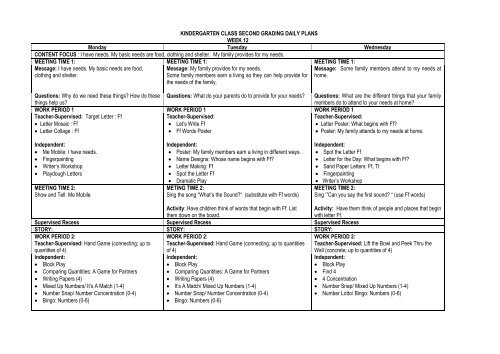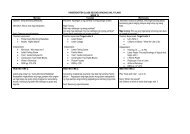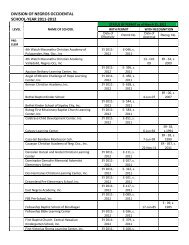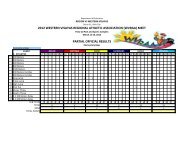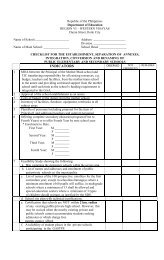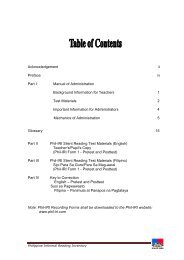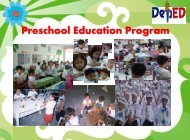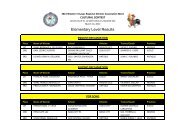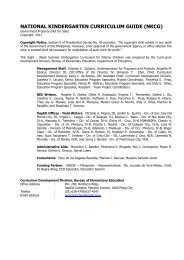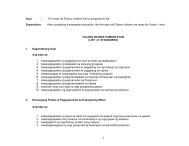KINDERGARTEN CLASS SECOND GRADING DAILY PLANS ...
KINDERGARTEN CLASS SECOND GRADING DAILY PLANS ...
KINDERGARTEN CLASS SECOND GRADING DAILY PLANS ...
You also want an ePaper? Increase the reach of your titles
YUMPU automatically turns print PDFs into web optimized ePapers that Google loves.
<strong>KINDERGARTEN</strong> <strong>CLASS</strong> <strong>SECOND</strong> <strong>GRADING</strong> <strong>DAILY</strong> <strong>PLANS</strong>WEEK 12Monday Tuesday WednesdayCONTENT FOCUS : I have needs. My basic needs are food, clothing and shelter. My family provides for my needs.MEETING TIME 1: MEETING TIME 1: MEETING TIME 1:Message: I have needs. My basic needs are food,clothing and shelter.Message: My family provides for my needs.Some family members earn a living so they can help provide forthe needs of the family.Questions: Why do we need these things? How do these Questions: What do your parents do to provide for your needs?things help us?WORK PERIOD 1 WORK PERIOD 1 WORK PERIOD 1Teacher-Supervised: Target Letter : FfTeacher-Supervised: Letter Mosaic : Ff Let‟s Write Ff Letter Collage : Ff Ff Words PosterMessage: Some family members attend to my needs athome.Questions: What are the different things that your familymembers do to attend to your needs at home?Teacher-Supervised: Letter Poster: What begins with Ff? Poster: My family attends to my needs at home.Independent: Me Mobile: I have needs. Fingerpainting Writer‟s Workshop Playdough LettersMEETING TIME 2:Show and Tell: Me MobileIndependent: Poster: My family members earn a living in different ways. Name Designs: Whose name begins with Ff? Letter Making: Ff Spot the Letter Ff Dramatic PlayMETING TIME 2:Sing the song “What‟s the Sound?“ (substitute with Ff words)Independent: Spot the Letter Ff Letter for the Day: What begins with Ff? Sand Paper Letters: Ff, Tt Fingerpainting Writer‟s WorkshopMEETING TIME 2:Sing „”Can you say the first sound? “ (use Ff words)Activity: Have children think of words that begin with Ff. Listthem down on the board.Activity: Have them think of people and places that beginwith letter Ff.Supervised Recess Supervised Recess Supervised RecessSTORY: STORY: STORY:WORK PERIOD 2: WORK PERIOD 2: WORK PERIOD 2:Teacher-Supervised: Hand Game (connecting; up to Teacher-Supervised: Hand Game (connecting; up to quantities Teacher-Supervised: Lift the Bowl and Peek Thru thequantities of 4)Independent: Block Play Comparing Quantities: A Game for Partners Writing Papers (4) Mixed Up Numbers/ It‟s A Match (1-4) Number Snap/ Number Concentration (0-4) Bingo: Numbers (0-6)of 4)Independent: Block Play Comparing Quantities: A Game for Partners Writing Papers (4) It‟s A Match/ Mixed Up Numbers (1-4) Number Snap/ Number Concentration (0-4) Bingo: Numbers (0-6)Wall (concrete; up to quantities of 4)Independent: Block Play Find 4 4 Concentration Number Snap/ Mixed Up Numbers (1-4) Number Lotto/ Bingo: Numbers (0-6)
INDOOR/OUTDOOR ACTIVITY:INDOOR/OUTDOOR ACTIVITY:INDOOR/OUTDOOR ACTIVITY:Walking Backwards RelayBody LettersWalk, Hop, JumpMEETING TIME 3: Dismissal Routine MEETING TIME 3: Dismissal Routine MEETING TIME 3: Dismissal RoutineTHURSDAY FRIDAY NOTESMessage: Some food comes from plants. Some food comesfrom animals.Message: I need food.Sometimes we grow our own food.Sometimes we buy food from other places e.g. market,sari-sari store or food stalls/stand.Questions: Where do you buy/get your food? What arethe places in your community that sell food? Who amongyou grow vegetables or fruit trees in your backyard?Questions: What food comes from plants? What food comesfrom animals?WORK PERIOD 1 WORK PERIOD 1Teacher-Supervised: Target Letter: TtTeacher-Supervised: Letter Mosaic : Tt Let‟s Write Tt Letter Collage : Tt Tt Words Poster Letter Poster: What begin with Tt?Independent:Independent: Food Baskets (Fruits and Vegetables in the Letter Making: TtCommunity) Sand Paper Letters: Ff, Tt Food in the Community RSW. p.251 Food Chart: Food that come from animals/plants Playdough: Iba‟t Ibang Pagkain Playdough: Iba‟t Ibang Pagkain Food Memory Game/Food Domino Food Memory Game/Food DominoMEETING TIME 2: MEETING TIME 2:show the food baskets to the class – talk about the show the food chart – talk about the food that comes fromdifferent fruits and vegetablesanimals and food that comes from plantsSupervised RecessSupervised RecessSTORY:STORY:WORK PERIOD 2: WORK PERIOD 2:Teacher-Supervised: Lift the Bowl and Peek Thru the Teacher-Supervised: Pictograph: Favorite Fruit (3 categories)Wall (concrete; up to quantities of 4)Independent:Independent: Block Play Block Play Find 4/ 4 Concentration Find 4 /4 Concentration Number Snap/ Mixed Up Numbers (1-4) Number Snap/ Mixed Up Numbers (1-4) Bingo: Numbers (0-6)/ Tapatan Bingo: Numbers (0-6) / TapatanINDOOR/OUTDOOR ACTIVITY: Fruit SaladINDOOR/OUTDOOR ACTIVITY: Body RelayMEETING TIME 3: Dismissal RoutineMEETING TIME 3: Dismissal Routine
APPENDIX: WEEK 12A. THEME-RELATED ACTIVITIESMe Mobile (My Needs)Objective/Competence: to identify his needsMaterials: cardboard, yarn, scissors, pencils, colored markers, crayonsNumber of players/participants: 6-8Procedure:1. Ask children to draw his needs.2. Let them color their drawings.3. Attach a yarn to each drawing.4. Have them label the drawing.5. Hang this where everyone can see.Poster: My family members earn a living in different ways.Objective/Competence: to identify family member‟s way of earning a livingMaterials: manila paper, papers, pencils, colored markers, crayonsNumber of Participants: 6-8 childrenProcedure:1. Have children draw different ways family members earn a living.2. Ask each student to write something about his drawing. Take down dictation if the child cannot write his own words or sentences yet.3. Paste their work on a manila paper, write the title of the activity and post on the wall.Poster: My family members attend to my needs at home.Objective/Competence: identify ways how their family members attend to their needsMaterials: manila paper, papers, pencils, colored markers, crayonsNumber of Participants: 6-8 childrenProcedure:1. Ask each student to draw different ways family members attend to his/her needs.2. Have him/her write something about his/her drawing. Take down dictation if the child cannot write his own words or sentences yet.3. Paste their work on a manila paper, write the title of the activity and post on the wall.Food in the Community RSW. p.251Plaudough: Iba’t Ibang PagkainObjective/Competency: To identify different kinds of foodMaterials: playdoughNumber of Players/Participants: 6-8 childrenProcedure:1. Give each child a medium-sized ball of playdough.2. Let them mold the playdough to form different kinds of food.3
Food Memory GameObjectives: To identify different kinds of foodTo remember the location of certain food cardsMaterials: 20 pieces of food cardsNumber of Players/Participants: 6-8 childrenProcedure:1. Sixteen cards are placed in the middle of the table, face down, in a 4 x 4 arrangement. The remaining cards are placed faced-down in a stack.2. The players take turns turning over two cards, trying to turn a pair that totals 10. If a pair can be made, the player keeps it and continues to play as long as he is successful. If he is notsuccessful, he returns the two cards to their original face-down positions and replaces any cards he took with new ones from the deck.3. With 16 face-down cards on the table, the turn passes to the next player to the left..4. The person who collects the greatest number of pairs is the winner.Variation: This game can be varied by increasing the number of cards placed on the table. A 5 x 5 or 6 x 6 arrangement may be more interesting.Food DominoObjectives: To recognize pictures of foods that are alikeMaterials: set of 28 food dominoesNumber of Players/Participants: 6-8 childrenProcedure:1. All dominoes are placed face down.2. Each player draws 7 dominoes.3. A player with a “double” begins play.4. Each player in turn says the food names and then plays as in a regular domino game.5. The winner is the player who has played all dominoes, or the player with the smallest number of dominoes when all players must pass.Chart: Food that come from plants/ Food that come from animalsObjectives: to distinguish which food items come from animals and which comes from plantsMaterials: manila paper, markers, crayons/colored markersPrepare a food chart beforehand. Write food comes from plants on top of the first column and food thatcomes from animals on the second column.Number of players/participants: 6-8 childrenProcedure:1. Ask children to draw food that comes from animals and food that comes from plants.2. Have them paste this on the appropriate column on the chart.Food BasketsObjective: Identify fruits and vegetables grown in the localityMaterials: drawing of food baskets on manila paper or kraft or scrap large pieces of papersmall pieces of paper crayons scissorscardboard or old folder glue or pasteProcedure:1. Sing with the pupils “Bahay Kubo”.2. Talk about the fruits and vegetables mentioned in the song. Emphasize to the children that tomato, singkamas and kundol are fruits.3. Ask pupils other fruits and vegetables they know aside from those mentioned in the song4
4. Let the pupils draw fruits and vegetables grow in their places. Color them, cut and paste in the basket.5. Let them identify their drawing after pasting them.B. MATH ACTIVITIESPictograph: Favorite Fruit (3 categories)Objective: to collect dataTo organize data using a pictographMaterials: Manila paper cut outs of 3 kinds of fruits glueEx.Prepare large graph on Manila paper where children will paste the fruit cut-out of their choice.Prepare cut-outs of fruits. Make sure fruit choices are those familiar to the children.bananasantolmangoesNo. of Participants: small groupProcedure:1. Ask children to name fruits they have eaten. Discuss what each looks like, taste like, smell like, feel like.2. From among the list choose three fruits that will be used for the 3 category graph.3. Show the graph drawn on Manila paper and say, “From the list of fruits we made earlier, I chose 3. Now look at these three fruits and choose which among these is your favorite”4. Call each child to choose a fruit. The child then gets a cut-out of that fruit and pastes this on the appropriate box.5. After the children have pasted their cut-outs, ask the following questions: Which fruit is liked the most? Which fruit is liked the least? If we arrange the fruits from the most liked to the least like, what would come first? Next? And last? What is the difference between the number of people who like bananas and the number of people who like mangoes? Bananas and santol? Mangoes and santol?C. OTHER MATH ACTIVITIESBlock PlayObjective: to explore the attributes of 3-dimensional or space figuresto understand the relationship between figuresto build structures using blocksMaterials: table or floor blocksNo. of Participants: 1-45
2. They each build the appropriate clothespin stack to match their cards.3. One child turns the more/less spinner. If it lands on less, the partner whose stack has lesser clothespins wins both stacks. If the spinner lands on more, the partner with more clothespinswins both stacks.4. They continue to take turns, each accumulating clothespins.5. When the time is up or the children decide to end the game, they snap together all the clothespins. They turn the spinner to see if the person who has accumulated more or less clothespinsis the winner.Hand Game (connecting level up to quantities of 4)Objective: to explore different combinations that make a given quantityMaterials: any kind of counter such as pebbles, chips, or sticks numeral cards work matsNo. of Participants: small groupProcedure:1. Teacher gives each child a given quantity of sticks, in this case 4.2. Children separate counters in different ways and verbalize the combinations that result.Teacher says: Children say: Teacher places these cards on theHand Game counting board"Place four sticks in your right"None and four is four." orhand.""Zero and four is four."0 4"Place one stick inyour left hand.""Place one more stick in yourleft hand.""Place one more stick in yourleft hand.""One and three isfour.""two and two is four.""three and one is four."1 32 23 1"Place one more stick in yourleft hand."""Three and none is three."or "Three and zero is four."40 Lift The Bowl (concrete, up to quantities of 4)Objective: to explore different combinations that make a given quantityMaterials: bowl or cup, any kind of counter such as pebbles, chips, or sticksNo. of Participants: small groupProcedure:Game proceeds as Hand Game but bowls are used for separating quantities.Teacher says:Children say:8
"Place four blocks under the bowl.""Place one block on the bowl.""Place two blocks on the bowl.""Place three blocks on the bowl.""Place four blocks on the bowl.""None and four is four." or "Zero and four is four.""One and three is four.""Two and two is four.""Three and one is four.""Four and none is four." or "Four and zero is four."Peek Through The Wall (concrete, up to quantities of 4)Objective: to explore different combinations that make a given quantityMaterials: a wall made of plastic with tape around the edges, any kind of countersProcedure:Game proceeds as Hand Game but walls are used for separating quantities.Teacher says:"Wall off no blocks.""Wall off one block.""Wall off two blocks.""Wall off three blocks.""Wall off four blocks."Children say:"None and four is four." or "Zero and four is four.""One and three is four.""Two and two is four.""Three and one is four.""Four and none is four." Or “Four and zero is four.”Find 4Objective: to explore different combinations that make 4Materials: 4 sets of numeral cards 0, 1, 2, 3, 4No. of Participants: 1-4Procedure:1. All cards are dealt. Last card is turned face up. Each player keeps the cards dealt to him in a stack, face-down, without looking at them.2. By turns, players turn over the top card of his stack. If this card can be used with one on the table to make a total of 4, the player can take it and keep the pair. If there are no cards that can beused, he has to discard his card in the middle of the table, face up.3. The player who collects the most number of pairs wins.4 Concentration9
Objective: to explore different combinations that make 4Materials: 4 sets of numeral cards 0, 1, 2, 3, 4Procedure:1. Sixteen cards are placed in the middle of the table, face down, in a 4 x 4 arrangement. The remaining cards are placed faced-down in a stack.2. The players take turns turning over two cards, trying to turn a pair that totals 4. If a pair can be made, the player keeps it and continues to play as long as he is successful. If he is notsuccessful, he returns the two cards to their original face-down positions and replaces any cards he took with new ones from the deck.3. With 16 face-down cards on the table, the turn passes to the next player to the left.4. The person who collects the greatest number of pairs is the winner.Variation: This game can be varied by increasing the number of cards placed on the table. A 5 x 5 or 6 x 6Number SnapObjective: to match numeralsNumber of Players/ Participants: 2-4Materials: 3 sets of number cards, 0-4Procedure:1. Shuffle and deal the cards.2. The players take it in turns to turn over their top card.3. If two matching cards are turned over, the first player to shout "snap" wins both the piles concerned.4. Continue until only one player is left.Variation: Make a set of cards with the numbers shown in different ways.Tapatan (tic-tac-toe's brainy Filipino cousin)Materials: playing board, 3 markers of two colors (3 red and 3 blue)Procedure:The object of the game is to arrange 3 markers of the same color in a row along any of the board lines (horizontally, vertically or diagonally). Players take turns placing one marker at a time on any ofthe board points. When all six pieces are placed, the players take turns sliding from point to point along the board lines until one player is able to arrange 3 markers of the same color in a row.D. OTHER LANGUAGE ARTS ACTIVITIESName Designs, Letter Making, Spot the Letter, Letter Mosaic, Letter Collage, Let’s Write, Word Poster, Letter Poster, Letter for the Day and Sand Paper Letters - please refer to Week 11appendixWriters’ WorkshopObjective: to represent experiences through drawingMaterials: ½ lengthwise bond paper, pencils, crayonsNumber of Players/Participants: 8 childrenProcedure:1. Ask each student to draw a particular experience he/she had and write about it.Take down dictation if the child cannot write his own words or sentences yet.2. Compile the stories and make it into a book.10
Fingerpainting – free explorationObjective/Competency: To develop self-expressionMaterials: fingerpaint (red, blue, yellow), white paper, tape, markers, wet cloth for wiping fingersNumber of Players/Participants: 6-8 childrenProcedure: Tape the paper on the table so that it will not move or fly away while the child is painting. Ask each child to write his name on the paper with a marker. Invite each child to dip his fingers in a tub of fingerpaint and apply the fingerpaint on his white paper to paint pictures. Teach the children to wipe his fingers clean with the cloth before dipping in another colored paint. When a child has finished painting, teacher asks him about his drawing and writes his answer on another piece of paper. Teacher hangs the painting up to dry. Teacher attaches the paper with his description of his painting when it is dry already.Playdough LettersObjective/Competency: To identify different lettersMaterials: playdoughNumber of Players/Participants: 6-8 childrenProcedure:1. Give each child a medium-sized ball of playdough.2. Let the children form different letters.3. Ask them to identify the letters as they create.E. SONGS/POEMS/ RHYMESWhat’s the Sound ?, Can you Say the First Sound? - please refer to Week 11 appendixFruit SaladWatermelon, watermelonPapaya, papayaSaging and banana (2x)Fruit salad (2x).Walk, Hop, Jump(to the tune of Fruit Salad)Kung Ang Ulan Ay Malapot Na SorbetesKung ang ulan ay malapot na sorbetes(masarap na tsokolate, malutong na mangga)O, kay sarap ng ulanAkoy lalabas at akoy ngangangaAh, ah, a-ah, ah, ah a-ahO, kay sarap ng ulan.Walking (4x)Hop (6x)Jumping (6x)Now we stop.Note: Do the action while singing the song.Variations: change the action words into any body11


